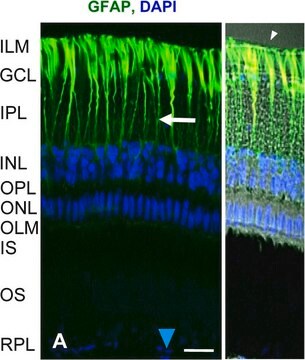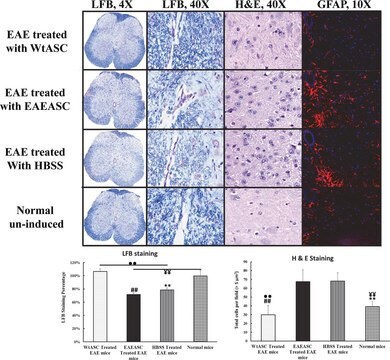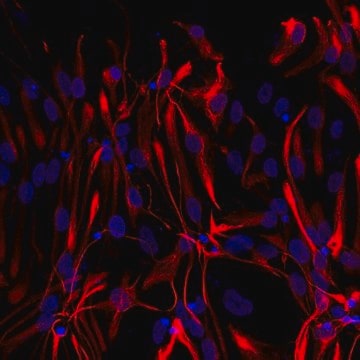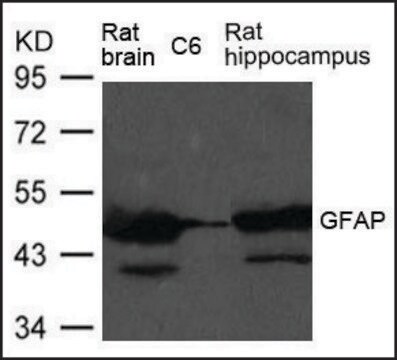G3893
Anti-Glial Fibrillary Acidic Protein Antibody
mouse monoclonal, G-A-5
Synonim(y):
Anti Gfap, Anti-Gfap, GFAP Antibody - Monoclonal Anti-Glial Fibrillary Acidic Protein (GFAP) antibody produced in mouse, Gfap Antibody, Glial Fibrillary Acidic Protein Antibody, Anti-GFAP
About This Item
Polecane produkty
Nazwa produktu
Monoclonal Anti-Glial Fibrillary Acidic Protein (GFAP) antibody produced in mouse, clone G-A-5, ascites fluid
pochodzenie biologiczne
mouse
białko sprzężone
unconjugated
forma przeciwciała
ascites fluid
rodzaj przeciwciała
primary antibodies
klon
G-A-5, monoclonal
reaktywność gatunkowa
rat, human, pig
metody
immunoblotting: suitable
immunocytochemistry: suitable
immunohistochemistry: 1:400 using rat brain sections (alcohol-fixed)
indirect immunofluorescence: suitable
microarray: suitable
izotyp
IgG1
numer dostępu UniProt
Warunki transportu
dry ice
temp. przechowywania
−20°C
docelowa modyfikacja potranslacyjna
unmodified
informacje o genach
human ... GFAP(2670)
rat ... Gfap(24387)
Opis ogólny
The isotype is determined using ImmunoTypeTM Kit (Product Code ISO-1) and by a double diffusion immunoassay using Mouse Monoclonal Antibody Isotyping Reagents (Product Code ISO-2).
Intermediate filaments (IFs) with characteristic 10 nm diameter are a distinct class of molecularly heterogenous cytoskeletal filaments defined by ultrastructural, immunological, and biochemical criteria. Intermediate filaments differ significantly from the other cytoskeletal elements of the cell, namely microtubules and microfilaments, and are components of most eukaryotic cells. GFAP (molecular weight of 50 kDa) is the cell specific IF protein in astrocytes.
Specyficzność
Immunogen
Zastosowanie
The antibody was used as a primary antibody in immunocytochemistry analysis:
- of primary cerebral microvascular EC cultures to study the effect of microglia on the BBB (blood-brain barrier) and its primary constituents
- to study the wound healing effects of matrix metalloproteinase-2 that promote recovery after spinal cord injury
- to study the negative regulation of embryonic neural progenitor cell proliferation by Toll-like receptor 3
Działania biochem./fizjol.
Postać fizyczna
Przechowywanie i stabilność
Oświadczenie o zrzeczeniu się odpowiedzialności
Nie możesz znaleźć właściwego produktu?
Wypróbuj nasz Narzędzie selektora produktów.
polecane
produkt powiązany
przeciwciało
Kod klasy składowania
10 - Combustible liquids
Klasa zagrożenia wodnego (WGK)
WGK 3
Temperatura zapłonu (°F)
Not applicable
Temperatura zapłonu (°C)
Not applicable
Wybierz jedną z najnowszych wersji:
Certyfikaty analizy (CoA)
Nie widzisz odpowiedniej wersji?
Jeśli potrzebujesz konkretnej wersji, możesz wyszukać konkretny certyfikat według numeru partii lub serii.
Masz już ten produkt?
Dokumenty związane z niedawno zakupionymi produktami zostały zamieszczone w Bibliotece dokumentów.
Klienci oglądali również te produkty
DYSMORPHIC FEATURES ASSOCIATED WITH
17q21.31 MICRODELETION SYNDROME
Produkty
Frequently asked questions about neural stem cells including NSC derivation, expansion and differentiation.
Nasz zespół naukowców ma doświadczenie we wszystkich obszarach badań, w tym w naukach przyrodniczych, materiałoznawstwie, syntezie chemicznej, chromatografii, analityce i wielu innych dziedzinach.
Skontaktuj się z zespołem ds. pomocy technicznej











